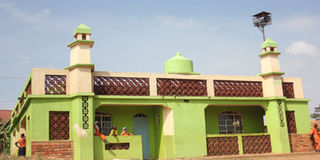The untold story of the Muslim martyrs

This small, green painted mosque is all there is in memory of the Muslim martyrs at Namugongo. PHOTO BY ABUBAKER LUBOWA
What you need to know:
Flash Back. The only symbol of their existence is a mud and wattle mosque in Namugongo, yet the Muslim martyrs were the earliest faithful to die because of their faith. We go back in time to uncover them.
Last month, on June 3, thousands of Christians thronged Namugongo, to commemorate the day the Uganda Martyrs met their creator. Before this lot, another group of martyrs had been killed in Namugongo. The year was 1876 and the king who ordered for their death was Kabaka Mutesa I. They too, died because of their disagreement with the Kabaka over their faith. And, the religion was Islam.
The genesis
Upon the death of Kabaka Ssuna, his son Mutesa I ascended onto the throne. Like was the way of his deceased father, Mutesa encouraged the Arab and Swahili traders from the coast, to visit his Kingdom. Overtime, a friendly relationship between the Kabaka and the traders was born. This gave the traders the comfort to start telling him about the religion of Prophet Muhammad.
Dr Abdu Kasozi, in his book Abaasimba Obuyisiraamu mu Uganda, writes that the Kabaka developed love for the religion and consequently converted to it. “After joining Islam, he embarked on a strategy of ensuring that his subjects embraced the religion. This involved encouraging them to learn Islam as well as follow its teachings. Mutesa himself played a leading role in observing these teachings. For example, he prayed five times a day, fasted during the month of Ramadhan, only ate meat that was slaughtered by a Muslim,” states Kasozi.
History has it that Mutesa was a very fast learner, an aspect that amazed his subjects.
When circumcision created a rift
As Islam continued to spread in the Kingdom, strains started appearing in the relationship between Mutesa and his fellow Muslim subjects. Nsereko Mutumba, the spokesperson of Uganda Muslim Supreme Council, says the genesis of the strains was the issue of circumcision. For one to qualify as a Muslim, one has to be circumcised, the Kabaka was no exception. “However, in Buganda, it was an abomination for a Kabaka to be circumcised. He was viewed as a flawless human being. Circumcision would change this. Therefore his wives and some of the nobles strongly advised him against being circumcised.”
Nsereko says this led to some Muslims despising Mutesa because he had not “faced the razor”. This attitude he says, was fanned by Turkish clerics from Egypt who had visited the kingdom. “When they learnt that Mutesa was not circumcised, they urged Baganda Muslims to disobey him. They started him a Kafiir. Mutesa was very irked by this.”
Religion and leadership
The last stroke that broke the camel’s back was the message from the Turks, asking the Muslims not to accept the Kabaka to lead them in prayers. Nsereko says in Buganda culture, the Kabaka was the supreme leader. “He was the leader of what was in heaven and earth, the leader of the animal and plant kingdom. Therefore, the idea of someone else leading him in prayer was treasonable.”
When the Kabaka learnt and verified the news of the desire by the Muslims to replace him as their leader in prayers, he immediately ordered for their killing. The book states that hundreds of Muslims who were privy to that plot were rounded up and burnt at Namugongo.
No cause for celebration?
Unlike the Christians, Muslims do not celebrate that day that these martyrs were burnt. Why? Sheikh Siliman Ndirangwa, a cleric from Kibuli Mosque, explains that it would be against the teachings of Islam. He says in Islam, there are three mourning days, beyond that, you are only expected to draw lessons from someone’s death, but not celebrate it.
When ex-President Idi Amin heard of the untold story of the Muslim martyrs, he set out to build a mosque in their memory. Land was secured opposite the current Anglican martyrs church in Namugongo. Unfortunately, Amin was ousted before the fruition of his idea. Nonetheless, a mosque (made of mud and wattle) was set up on the site.
“During Obote II regime, the mosque was occupied by his soldiers. In mockery of the Muslims, they used to slaughter pigs there. When Museveni’s came to power, the mud and wattle mosque was dismantled and a new and permanent one was constructed.” says Muhammad Guyidde, the mosque’s Imam. Therefore, the small, green painted mosque is all there is in memory of the Muslim martyrs.




